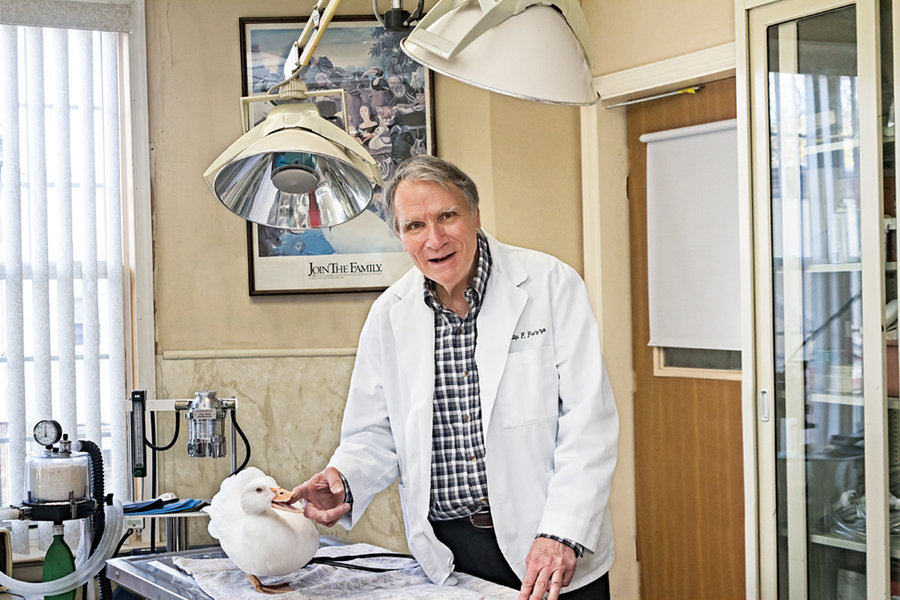The Animal Clinic of Bayonne
Dr. Philip Frezzo
926 Broadway
(201) 437-6666
animalclinicofbayonne.com
On a Wednesday afternoon in mid-November, a yellow Lab named Marley tries unsuccessfully to remove the plastic lampshade around his neck. The waiting room is humming. Staff bustles in and out, and patients wait anxiously with their humans.
The clinic is a warren of exam rooms and labs on the first floor. In one, Dr. Philip Frezzo shows me a shelf of old medical texts, dog-eared (pun intended) from use. A laptop sits just below the shelf, but he would rather look stuff up in books.
At the same time, he’s proud of all the latest technology—digital x-rays, electronic weighing/exam tables, 3-D ultrasound, incubators, cardiac monitors, video endoscopy, CAT scans, gas sterilizers, chemo, MRIs. There’s an eye chart for animals who know their alphabet.
“Now veterinary medicine is almost as advanced as human medicine,” Frezzo says.
But you could say that the heart and soul of the place are the live-in animals—a few cats, two dogs that couldn’t find homes, parrots Jack and Toby who were found on the street, a turtle, a duck.
Mrs. Duck has been living at the clinic for about six years, rescued after a vicious dog attack, none the worse for wear, with only one leg and half a beak. She takes 40-gallon tub baths, sleeps on a towel, lays eggs, and eats calcium-fortified duck food, which is why she’s pure white.
According to Frezzo, if she were still living in the bay, eating fresh fish, algae, bugs, and grubs, she’d be the color of whatever she eats. (Might want to lay off the Gummy Bears!)
Ethel Baczyk is the head technician. She’s wearing bright red scrubs and is the guardian of a box turtle named Hobbes who has been living at the clinic for 15 years. Hobbes tears across the exam room at breakneck speed. Just kidding. He proceeds with stereotypical slowness, but his mind is quick.
“People don’t believe how smart turtles are,” Frezzo says. “They’re very intelligent.” Hobbes is currently studying for his GED.
Broadway Institution
Dr. Philip Frezzo opened his veterinarian practice at 926 Broadway in 1982 and has been at that locale ever since. But there have been lots of changes over those three decades. Back then, he had one employee. And, wonder of wonders, he did house calls! Now there are six vets and a staff of 25, half full time and half part time. He’s open seven days a week and four nights a week. But no house calls—for the most part.
The types of animals treated have also changed. Now it’s mostly cats and dogs, aside from a few parrots and other birds. “We used to see a lot of iguanas and a lot of snakes, but people aren’t buying as many boa constrictors as they did before.”
Frezzo sees that as a good thing. “You can’t keep a snake in a cage,” he says, “and feed it the same thing. It needs a varied diet and sunlight. They need to stretch themselves and move about and not be in a tank or small area. With large snakes, there are a lot of problems with constipation.” They used to see snakes as large as 15 feet.
Yuck all around!
The practice also used to see more ferrets, minks, chinchillas—and sugar gliders, those small, omnivorous, arboreal and nocturnal gliding possums. The name derives from its fondness for sugary foods and ability to glide through the air like a flying squirrel. As you know, it’s Latin name means “short-headed rope-dancer.”
“People in Bayonne also used to keep a lot of monkeys in their homes, but no more,” says Frezzo. “Now they’re putting controls on exotic animals.”
Frezzo supports the controls, citing the case of iguanas. “They can’t live on vegetables and lettuce and leafy greens,” he says. “They need protein and calcium, and they need to be in their natural environment.” Once, a three-foot lizard walked in without a tail. Frezzo cautions that monitor lizards have a “terrible bite.”
Cats and dogs, on the other hand, are domesticated and accustomed to sharing the planet with humans. Dogs are omnivores, and cats are carnivores, which makes them easy to feed.
Dogs are like clothes; various breeds go in and out of fashion. In the last few years, Frezzo says, it’s been Dobermans, German Shepherds, and Rotweilers. Now it’s pit bulls, because “that’s what’s available at the shelters for adoption,” Frezzo says, adding that he also sees pugs, terriers, and other small breeds.
The clinic treats some specific cat breeds, such as ragdolls, ocicats, Siamese, and Persians, but mostly they’re seeing long- or short-haired domestic felines.
One-Stop Shopping
The practice occupies three full floors, offering a full menu of medical services and all types of surgery, including minimally invasive procedures. A full-time vet lives on the premises.
“I’ve always had the good fortune of having a lot of medical cases over the years,” Frezzo says, “not just vaccinations and well dogs. People need to be educated on what vets do. It’s not just spays and castrations.” (Phew!)
Frezzo has one bit of advice for folks with pets. “A lot of treats and other products are packaged in the U.S. but produced in China,” he says. “There are problems with quality control in China. The treats can be toxic and cause intestinal problems and even death.”
Frezzo loves caring for animals, no matter what the type or what the treatment.
“I’ve always wanted to be a vet,” he says. “It was my life’s ambition.”—BLP
